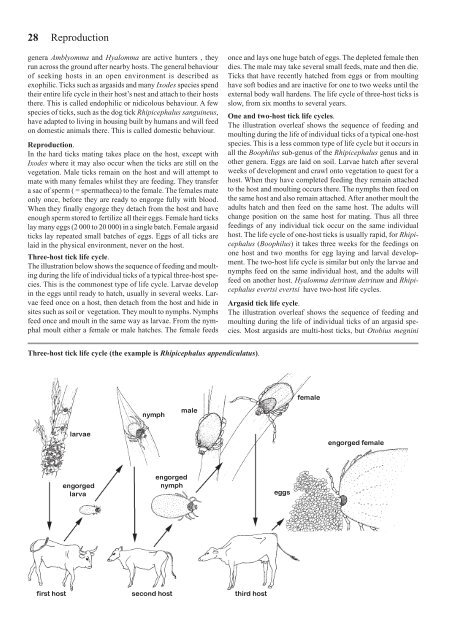Ticks of Domestic Animals in Africa - Alan R Walker - Science Writer
Ticks of Domestic Animals in Africa - Alan R Walker - Science Writer
Ticks of Domestic Animals in Africa - Alan R Walker - Science Writer
Create successful ePaper yourself
Turn your PDF publications into a flip-book with our unique Google optimized e-Paper software.
28 Reproduction<br />
genera Amblyomma and Hyalomma are active hunters , they<br />
run across the ground after nearby hosts. The general behaviour<br />
<strong>of</strong> seek<strong>in</strong>g hosts <strong>in</strong> an open environment is described as<br />
exophilic. <strong>Ticks</strong> such as argasids and many Ixodes species spend<br />
their entire life cycle <strong>in</strong> their host’s nest and attach to their hosts<br />
there. This is called endophilic or nidicolous behaviour. A few<br />
species <strong>of</strong> ticks, such as the dog tick Rhipicephalus sangu<strong>in</strong>eus,<br />
have adapted to liv<strong>in</strong>g <strong>in</strong> hous<strong>in</strong>g built by humans and will feed<br />
on domestic animals there. This is called domestic behaviour.<br />
Reproduction.<br />
In the hard ticks mat<strong>in</strong>g takes place on the host, except with<br />
Ixodes where it may also occur when the ticks are still on the<br />
vegetation. Male ticks rema<strong>in</strong> on the host and will attempt to<br />
mate with many females whilst they are feed<strong>in</strong>g. They transfer<br />
a sac <strong>of</strong> sperm ( = spermatheca) to the female. The females mate<br />
only once, before they are ready to engorge fully with blood.<br />
When they f<strong>in</strong>ally engorge they detach from the host and have<br />
enough sperm stored to fertilize all their eggs. Female hard ticks<br />
lay many eggs (2 000 to 20 000) <strong>in</strong> a s<strong>in</strong>gle batch. Female argasid<br />
ticks lay repeated small batches <strong>of</strong> eggs. Eggs <strong>of</strong> all ticks are<br />
laid <strong>in</strong> the physical environment, never on the host.<br />
Three-host tick life cycle.<br />
The illustration below shows the sequence <strong>of</strong> feed<strong>in</strong>g and moult<strong>in</strong>g<br />
dur<strong>in</strong>g the life <strong>of</strong> <strong>in</strong>dividual ticks <strong>of</strong> a typical three-host species.<br />
This is the commonest type <strong>of</strong> life cycle. Larvae develop<br />
<strong>in</strong> the eggs until ready to hatch, usually <strong>in</strong> several weeks. Larvae<br />
feed once on a host, then detach from the host and hide <strong>in</strong><br />
sites such as soil or vegetation. They moult to nymphs. Nymphs<br />
feed once and moult <strong>in</strong> the same way as larvae. From the nymphal<br />
moult either a female or male hatches. The female feeds<br />
Three-host tick life cycle (the example is Rhipicephalus appendiculatus).<br />
larvae<br />
engorged<br />
larva<br />
nymph<br />
engorged<br />
nymph<br />
male<br />
first host second host third host<br />
once and lays one huge batch <strong>of</strong> eggs. The depleted female then<br />
dies. The male may take several small feeds, mate and then die.<br />
<strong>Ticks</strong> that have recently hatched from eggs or from moult<strong>in</strong>g<br />
have s<strong>of</strong>t bodies and are <strong>in</strong>active for one to two weeks until the<br />
external body wall hardens. The life cycle <strong>of</strong> three-host ticks is<br />
slow, from six months to several years.<br />
One and two-host tick life cycles.<br />
The illustration overleaf shows the sequence <strong>of</strong> feed<strong>in</strong>g and<br />
moult<strong>in</strong>g dur<strong>in</strong>g the life <strong>of</strong> <strong>in</strong>dividual ticks <strong>of</strong> a typical one-host<br />
species. This is a less common type <strong>of</strong> life cycle but it occurs <strong>in</strong><br />
all the Boophilus sub-genus <strong>of</strong> the Rhipicephalus genus and <strong>in</strong><br />
other genera. Eggs are laid on soil. Larvae hatch after several<br />
weeks <strong>of</strong> development and crawl onto vegetation to quest for a<br />
host. When they have completed feed<strong>in</strong>g they rema<strong>in</strong> attached<br />
to the host and moult<strong>in</strong>g occurs there. The nymphs then feed on<br />
the same host and also rema<strong>in</strong> attached. After another moult the<br />
adults hatch and then feed on the same host. The adults will<br />
change position on the same host for mat<strong>in</strong>g. Thus all three<br />
feed<strong>in</strong>gs <strong>of</strong> any <strong>in</strong>dividual tick occur on the same <strong>in</strong>dividual<br />
host. The life cycle <strong>of</strong> one-host ticks is usually rapid, for Rhipicephalus<br />
(Boophilus) it takes three weeks for the feed<strong>in</strong>gs on<br />
one host and two months for egg lay<strong>in</strong>g and larval development.<br />
The two-host life cycle is similar but only the larvae and<br />
nymphs feed on the same <strong>in</strong>dividual host, and the adults will<br />
feed on another host. Hyalomma detritum detritum and Rhipicephalus<br />
evertsi evertsi have two-host life cycles.<br />
Argasid tick life cycle.<br />
The illustration overleaf shows the sequence <strong>of</strong> feed<strong>in</strong>g and<br />
moult<strong>in</strong>g dur<strong>in</strong>g the life <strong>of</strong> <strong>in</strong>dividual ticks <strong>of</strong> an argasid species.<br />
Most argasids are multi-host ticks, but Otobius megn<strong>in</strong>i<br />
eggs<br />
female<br />
engorged female


